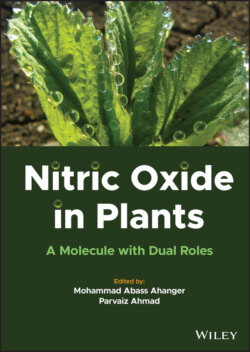Читать книгу Nitric Oxide in Plants - Группа авторов - Страница 13
1.3.1 Interaction of NO with Other Molecules to Confer Biotic Stress Responses in Plants
ОглавлениеPlants defend themselves against microorganism attack by activating elaborate defenses. Similarly, it has been recently demonstrated first that NO acts synergistically with ROS to extend host death in soybean suspension cells, and second that NOS inhibitors compromise the hypersensitized resistance response in Arabidopsis and tobacco (Delledonne et al. 1998). NO and ROS induce SA synthesis, and elevated SA may subsequently result in improved NO and ROS levels. SA additionally induces expression of genes that may be NO targets/sensors (e.g. pathogen-induced oxido-reductase [PIOX]). What is more, SA may enhance the results of NO activity through interaction with many NOX-regulated enzymes (e.g. catalase and aconitase). On the other hand, SA, which is a very important antioxidant in mammals, may counter the effects of NO. As an example, NO blocks respiration via inhibition of cytochrome enzyme, while SA induces production of various NO-resistant enzymes and sensors/targets in plants (e.g. pathogen-induced oxygenase, PIOX). NO and SA have an effect on common targets (e.g. catalase, aconitase). SA counteracts NO action (e.g. NO inhibits cytochrome enzyme, whereas SA induces a different oxidase). The induction of necrobiosis and/or defense factor activation occurs via the action of NO, SA, and ROS. NO is not only thought to perform throughout the event of hypersensitive cell death but is also needed in the establishment of disease resistance. Melatonin also enhances pathogen resistance in plants by increasing the levels of SA and ethylene. Lee et al. (2015) reported that decreased level of melatonin content in Arabidopsis mutant lowers the SA content thereby reducing resistance to pathogen infection. It also stimulates elevation of endogenous NO levels and increased expression of defense-related genes, along with disease resistance against Pst DC3000 infection.
Melatonin confers plants with innate immunity via the NO- and H2O2-dependent pathway by stimulating mitogen-activated protein kinase kinase kinase 3 (MAPKKK3) and oxidative signal-inducible1 (OXI1). Melatonin stimulates accumulation of NO and SA and improved tomato TMV resistance (Zhao et al. 2019).
Interaction between NO and glutathione is an important component to the NPR1-dependent defense signaling pathway in A. thaliana (Kovacs et al. 2015). Cao et al. (2019) found that brassinosteroids aid in stimulating the susceptibility of maize to maize chlorotic mottle virus infection in a NO-dependent manner. Nitric oxide further acts as a downstream signaling molecule in brassinosteroid-mediated virus susceptibility to maize chlorotic mottle virus in maize. The brassinosteroids provide systemic resistance against viruses along with H2O2 and NO in Nicotiana benthamiana (Deng et al. 2016). However, several studies have demonstrated the integrative role of brassinosteroids with NO in response to pathogen attack in various species (Hayat et al. 2010; Shi et al. 2015; Zou et al. 2018; Kohli et al. 2019).
